Talysh people
The Talysh people (Talysh: Tolışon تالشان) are an Iranian[9][10] ethnic group indigenous to the Talish region shared between Azerbaijan and Iran which spans the South Caucasus and the southwestern shore of the Caspian Sea. They speak the Talysh language, one of the Northwestern Iranian languages. It is spoken in the northern regions of the Iranian provinces of Gilan and Ardabil and the southern parts of the Republic of Azerbaijan. The areas in the Republic of Azerbaijan where Northern Talysh is spoken was historically known as Talish-i Gushtasbi. In Iran there is a Talesh County in Gilan Province.[11]
Tolışon • Talışlar • تالشان | |
|---|---|
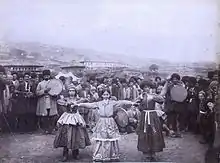 Talysh people dancing, early 20th century in Iran | |
| Regions with significant populations | |
| 700,000–1,000,000[1] | |
| 500,000[2]–1,000,000[3][4] | |
| 2,529 (2010 census)[5] | |
| Languages | |
| Talysh | |
| Religion | |
| Islam (predominantly Shia in Azerbaijan, predominantly Sunni in Iran[6][7][8]) | |
| Related ethnic groups | |
| Gilak people, Iranian peoples | |
Origins
The Talyshis have traditionally inhabited the Talish[lower-alpha 1] district in the southwestern part of the Caspian Sea, which is usually considered to extend more than 150 km. Today, the northern part of Talish is located in the Republic of Azerbaijan, encompassing the districts of Lankaran, Astara, Lerik, Masally, and Yardimli. The southern part of Talish encompasses the western part of the Gilan province of Iran,[12] extending to the village of Kapurchal.[13]
It is challenging to determine the Talyshis origin because so little is known about them prior to the modern era. Like other ethnonyms, the name Tāliš cannot be established with certainty. It appears in early Arabic sources as al-Țaylasān.[12] According to Al-Tabari (died 923); "In the mountains surrounding Azarbaijan there used to live such peoples as the Gels and the al-Taylasan, who did not obey the Arabs and mastered their freedom and independence".[14] In Persian, they are called Țālišān and Țavāliš, both plural versions of Tāliš.[12] The native transliteration of Tāliš first appears in the 16th-century, in the Armenian version of the Alexander Romance; "And he related that he is a refugee from the Caspian gates, near the country of Talish, in the province of Gilan."[7]
Local Talysh experts commonly claim that the Talyshis are descended from the Cadusii, an ancient tribe which inhabited the district. According to Garnik Asatrian and Habib Borjian; "this is one of the rare cases when a folk self-identification with an ancient people can be, at least tentatively, substantiated with historical and linguistic backgrounds."[15] The Iranologist Richard N. Frye believed that the Talyshis are possibly descended from the Cadusii.[16]
History
In Safavid Iran
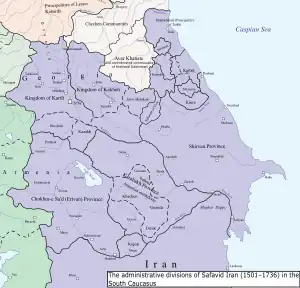
Talish has traditionally been associated with either Gilan or Mughan, especially with Ardabil, the center of the latter, which appears to have shared a similar linguistic and ethnic bond with Talish prior to the Turkicization of Iranian Azerbaijan. This connection was still apparent during the time of the early Safavids, who were descended from Safi-ad-din Ardabili (died 1334), a disciple of Zahed Gilani (died 1301), who was of probable Talysh descent. Two out of the four Sufi teachers of the first Safavid monarch Shah Ismail I (r. 1501–1524) carried the epithet "Talishi".[7] Other figures with the same epithet served as governmental officials under the Safavids and their successors.[7] Several Talysh chieftains were one of the first supporters of the Safavids, who gave them the governorship of Astara,[17] which was part of the province of Azerbaijan.[18] The governor of Astara was also known as the hakem (governor) of Talish, which indicates that Astara was the capital of the district. From 1539 and onwards the governorship of Astara was held hereditarily by the family of Bayandor Khan Talesh.[18]
Talish was composed of various fiefs which would sometimes be granted to other emirs than the governor of Talish. For instance, Mohammad Khan Torkman was given control over a number of fiefs in Talish and Mughan in 1586.[18] Later in 1684, Safiqoli Khan was one of the officers in control of Lankaran, and Hoseyn was another. Meanwhile, the unnamed governor of Talish lived in Ardabil.[19] The Safavid shahs (kings) of Iran attempted to control local Talysh chiefs by subordinating them to obedient officials. Nevertheless, despite their centralization strategy, the Safavid administration was unable to terminate the local autonomy in the South Caucasus.[20] Officially, the local chiefs were not hereditary lords, but officials whose rank were acknowledged by a royal farman (edict) which in reality was an acceptance of their local autonomy. The familial succession of the chiefs gave rise to dynasties that dominated local affairs and sought to consolidate their influence whenever the national government weakened.[20]
During the decline of Safavid rule in the early 18th-century, Talysh leaders attempted to establish autonomous principalities.[20] During the Russian invasion of Iran, the people of Talish volunteered to fight for the Safavid monarch Tahmasp II (r. 1722–1732). The latter was unable to provide them with military or material support; all he could do was give them an ineffective permit that allowed them to collect the taxes of Rasht.[21] In 1723, Russians and Ottomans agreed to divide northern and western Iran between themselves.[22] While the Caspian provinces were under Russian control, one of the local leaders Mir-Abbas Beg, who claimed to be a seyyed (descendant of the Islamic prophet Muhammad), worked together with the Russian commander Mikhail Matyushkin.[20] By the end of 1735, the reconquest of northern and western Iran was completed, being led by the Iranian military leader Nader.[23] It was also during this period that he set his sights on the throne, as he believed his campaigns had stabilised the country and brought him enough fame. On 8 March 1736, he was crowned the new shah of Iran, marking the start of the Afsharid dynasty.[24]
In Afsharid and Zand Iran
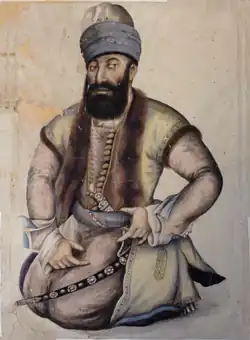
Mir-Abbas Beg kept up his relations with the Russians even after they pulled out of Iran. In order to demonstrate his loyalty to Nader Shah, he sent his son Jamal al-Din as a hostage to his court. Due to his dark complexion, Jamal al-Din earned the nickname Qara ("the Black") Beg. He rose to important posts in Nader Shah's army and was assigned the task of putting down Kalb Hoseyn Beg's uprising in southern Talish in 1744.[20] The murder of Nader Shah in 1747 led to the fragment of his empire; in the same fashion as the other rulers in the Southern Caucasus, Jamal al-Din (who had succeeded his father) established himself as a semi-independent ruler, marking the start of the Talysh Khanate, which used Lankaran as its capital.[25] A khanate was a type of administrative unit governed by a hereditary or appointed ruler subject to Iranian rule. The title of the ruler was either beglarbegi or khan, which was identical to the Ottoman rank of pasha.[26] The khanates were still seen as Iranian dependencies even when the shahs in mainland Iran lacked the power to enforce their rule in the area.[27][28]
Jamal al-Din preserved his fathers correspondence with Russia, sending a letter to its empress Catherine II (r. 1762–1796) that pledged his allegiance to her and offered the Russian troops access to his domains. The Zand ruler of Iran, Karim Khan Zand (r. 1751–1779) was informed of this by Zohrab Beg, one of the grandees of Talish. As a result, Jamal al-Din was sent to a prison in Shiraz, the Zand capital. Karim Khan soon reversed his decision after he had discovered that Zohrab Beg had made an agreement with his rival Hedayat-Allah Khan, who ruled Gilan.[25] Jamal al-Din was thus reinstated in Talish as its governor, being given the title of khan.[17] After destroying Zohrab's army and seizing control of Uluf and Dashtvand, Jamal al-Din now directed his attention towards Astara. He captured and killed its ruler Shoja al-Din, but failed to establish his rule in Astara, as the city was given to Shoja al-Din's son by Karim Khan in an attempt to restrict Jamal al-Din's authority. The latter, however, was able to conquer a number of towns in Talish and gain control over most of the region.[25]
After having made peace with Hedayat-Allah Khan in 1767, Karim Khan confirmed the latter as the ruler of Gilan. The following year, Hedayat-Allah Khan launched an attack into Talish, where he defeated and captured Jamal al-Din, imprisoning him in Rasht.[25] He then installed Jamal al-Din's son Mir-Askar Beg as the governor of Talish.[17] In 1772, Jamal al-Din broke out of prison and went back to Talish.[25] In 1784, the Talysh Khanate was attacked by Fath Ali Khan of Quba, the most dominant khan in the Caucasus. He made Jamal al-Din his vassal and also had him imprisoned in Baku. Due to pressure from Russia, however, Jamal al-Din was soon released.[29] In 1786, Jamal al-Din died and was succeeded by his son Mir-Mostafa Khan.[30]
In Qajar Iran
Following the death of Fath-Ali Khan in 1789, Mir-Mostafa was able to rule more autonomously. However, a new threat soon emerged. Since the death of Karim Khan in 1779, Agha Mohammad Khan Qajar of the Qajar dynasty was attempting to reestablish the Iranian empire under his own rule.[30] He issued threatening letters to the khans who had established connections with Russia in an effort to reestablish Iranian dominance over the border districts.[31] In 1791, Agha Mohammad Khan plundered Talish, but did not succeed in subjugating it.[32]
Agha Mohammad Khan was prepared to reinstate Iranian rule in the southeastern Caucasus by the summer of 1795. His 60,000 soldiers, which was primarily made up of cavalry, advanced into the area in the summer of that year. The first few months were spent by Agha Mohammad Khan winning the Muslim rulers' compliance. Mir-Mostafa and two other khans (Ibrahim Khalil Khan of Karabakh and Mohammad Khan Qajar of Erivan) entered into correspondence with the Russians, who gave them hope that they could defeat the Iranian forces. Heraclius also contacted the Russians, asking them for assistance against the impending invasion. Agha Mohammad Khan first directed his attention towards Talish; 10,000 soldiers led by Mostafa Khan Qajar was sent to Talish, which quickly submitted.[33]
In the Russian Empire and Soviet Union
Russia more or less openly pursued a policy to free their newly conquered land from Iran's influence. By doing this, the Russian government helped to create and spread a new Turkic identity that, in contrast to the previous one, was founded on secular principles, particularly the shared language. As a result, many Iranian-speaking residents of the future Azerbaijan Republic at the time either started hiding their Iranian ancestry or underwent progressive assimilation.[6] In the early Soviet period, there were Talysh high schools, a newspaper called "Red Talysh", and several Talysh language books published, but by end of the 1930s these schools were closed and the Talysh identity was not acknowledged in official statistics, with the Talysh being classified as "Azerbaijani".[34]
In the Republic of Azerbaijan
Historical repression of identity and the inability to practice their culture and language has led the Talysh to an internalized self-repression.[34] This makes it difficult to gauge support for any type of Talysh movement.[34] According to Hema Kotecha, many Talysh fear being associated with the separatist Talysh-Mughan Autonomous Republic, with Russia, or with Armenia if they acknowledge or attempt to talk about their beliefs in the public sphere. The fear of the police is another factor to this silence, although support for secular democracy and shared Azerbaijani-Talysh feelings towards Nagorno-Karabakh contribute as well.[34]
Radio Free Europe/Radio Liberty voiced their concerns about the arrest of Novruzali Mamedov, Chairman of the Talysh Cultural Centre and editor-in-chief of the Tolyshi Sado newspaper.[35] According to a U.S. government interview with Khilal Mamedov, a Talysh rights activist, Mr. Mamedov: “Accused the Azerbaijani leadership of Turkic nationalism and of seeking to suppress non-Turkic minorities…. He said the Azerbaijani leadership seeks to minimize contacts between the Talysh communities in Azerbaijan and Iran and to run Azerbaijan into a monoethnic state.”[36]
As of 2008, Ismail Shabanov was the president of the Talysh diaspora of Russia.
The National Talysh Movement (NTM) was formally created in 2007 by Talysh leaders exiled in the Netherlands. The members of the organization include those who were in support of the Talysh-Mughan Autonomous Republic such as Alikram Hummatov, the self-proclaimed president of Talysh-Mughan. The movement favors an autonomous region within Azerbaijan. It also demands the promotion of democratic, cultural, and linguistic rights of all minorities within Azerbaijan.[37]
Language
The Talysh language is a Northwestern Iranian language, being part of Tatic language family. Despite the absence of older Talysh texts, it is considered to be descended from Old Azeri, the indigenous Iranian language of Iranian Azerbaijan.[38][39]
Talysh has three major dialects, Southern Talyshi (Masali, Masulei, Shandermani and others), Central Talyshi (Asalemi, Hashtpari and others) and Northern Talyshi (spoken in four closely linked dialect sections of Lerik, Masally, Lankaran, Astara in Azerbaijan Republic and in the dialects of Astara, Sayyadlar, Vizane, as well as Anbaran and neighbouring villages in Iran). A transitional stage of these dialects also exist, such as in Jow Kandan-e Bozorg, where a transition between Northern to Central Talyshi is spoken.[40] Linguist Donald Stilo argues that Northern and Southern Talyshi should be regarded as individual languages in the same manner as the Kurdish languages, due to the low intelligibility between the two.[41]
Culture and religion
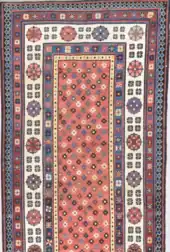
The Safavids' campaign of Shi'ite proselytism in Talish remained unfinished because of the district's mountainous, remote location. Because of this, a substantial number of the Talyshis in Iran and the Azerbaijan Republic are adherants of Sunni Islam. The majority of the Talyshis in the Iranian portion of Talish are Sunnis and adherents of the Naqshbandi order. On the other hand, the majority of Talyshis in the Azerbaijani portion of Talish are Shi'ites, with the exception of around twenty-four mountain villages.[7]
Despite the fact that the Talyshis in both Iran and Azerbaijan have a distinctive Iranian identity, its importance in Azerbaijan is considerably bigger. Their identity in Azerbaijan is built on the conflict between Iranians and Turks.[42] They have developed a strong sense of self-identity as a result of consistently receiving unfaithful treatment on behalf of Azerbaijan.[15] One of the main drivers of the growing Iranian identity of the Talyshis in Azerbaijan was the rise of the Pan-Turkist ideology in the country after the Soviet era.[4] The Talyshi identity in Azerbaijan has grown significantly during the past few decades. Even after the Talysh-Mughan Autonomous Republic was abolished, Talyshis in Azerbaijan and Russia's diaspora firmly believe in the possibility of an independent Talysh state.[9]
Meanwhile, among the Talyshis of Iran, the search for Iranian forebears among the South Caspian indigenous peoples is an essential sign of their Iranianness.[42]
Location

Most Talysh in the Republic of Azerbaijan live in a region that stretches from the western bank of the Vilaj River in the north to the Iranian border in the south and from the Caspian Sea in the east to the Iranian border in the West. This region covers the five political districts of Astara, Lankəran, Lerik, Masallı, and Yardımlı. Within these five districts there are over 350 Talysh villages and towns. In recent years, Talysh have also settled in other parts of Azerbaijan. Pockets of Talysh can be found south of the Kura River in the Bilasuvar, Neftcala, and Calilabad districts. Large numbers of Talysh have also moved to the urban surroundings of the capital, Baku. In particular, the cities of Bina and Sumqayıt have seen an influx of Talysh.[43]
Demographics
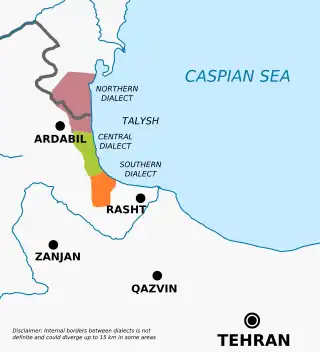
According to the Russian Imperial Census of 1897 there were 34,994 Talysh in Baku Governorate.[44]
According to a 1926 census, there were 77,039 Talysh in Azerbaijan SSR. From 1959 to 1989, the Talysh were not included as a separate ethnic group in any census, but rather they were included as part of the Turkic-speaking Azerbaijanis, although the Talysh speak an Iranian language.
According to the official 1999 census of the Republic of Azerbaijan the number of Talysh people in the Republic of Azerbaijan was 76,000.[45]
Talysh nationalists have always asserted that the number of Talysh in Azerbaijan is substantially higher than the official statistics.[46][47] According to unofficial statistics, between 200,000 and 300,000 Talysh citizens live in Azerbaijan.[46][47] Some claim that the population of the Talysh inhabiting the southern regions of Azerbaijan is 600,000.[34] The number of Talysh speakers in 2003 was estimated to be at least 400,000 in the Republic of Azerbaijan.[48]
According to some sources, the Azerbaijani government has also implemented a policy of forceful integration of all minorities, including Talysh, Tat, and Lezgins.[49] However, in a view of Hema Kotecha "the attitude towards any separatist tendencies seems predominantly negative" among the Talysh.[34] According to Swedish scholar on Eurasia Svante E. Cornell Azerbaijani government denies Lezgins claim that the number of Lezgins is many times higher than official numbers, but in private many Azeris acknowledge the fact that Lezgins – for that matter Talysh or the Kurdish population of Azerbaijan is far higher than the official figure. [50]
Obtaining accurate statistics is difficult, due to the unavailability of reliable sources, intermarriage, and the decline of the Talysh language.[51][52]
Genetics
With regards to their NRY-Y-DNA haplogroups, the Talysh show salient Near-Eastern affinities, with haplogroup J2, associated with the advent and diffusion of agriculture in the neolithic Near East, found in over 25% of the sample.[53] Another patriline, haplogroup R1, is also seen to range from 1/4 to up to 1/2, while R1a1, a marker associated with Eastern Indo-European, which includes Indo-Iranian peoples of Central/South Eurasia, only reaches to under 5%, along with haplogroup G.[53]
Notes
- Also transliterated as Talesh, Talysh, Tolysh.[12]
References
- Arakelova 2022, p. 411.
- Stilo 2015, pp. 414–415.
- Arakelova 2022, p. 410.
- Ter-Abrahamian 2005, p. 122.
- "Впн-2010". Archived from the original on 2 May 2013. Retrieved 3 July 2020.
- Ter-Abrahamian 2005, p. 121.
- Asatrian & Borjian 2005, p. 44.
- Arakelova 2022, pp. 413–414.
- Arakelova 2022, p. 416.
- Fard, Basiri & Yazdani 2019, p. 190.
- Народы мира : энциклопедия. Olma Media Group. 2007. p. 201. ISBN 978-5-373-01057-3. Archived from the original on 4 February 2021. Retrieved 20 October 2020.
- Asatrian & Borjian 2005, p. 43.
- Arakelova 2022, pp. 408.
- Asatrian & Borjian 2005, pp. 43–44.
- Asatrian & Borjian 2005, p. 46.
- Frye 1984, p. 32.
- Bournoutian 2021, p. 255.
- Floor 2008, p. 149.
- Floor 2008, pp. 149–150.
- Shahvar & Abramoff 2018, p. 27.
- Arjomand 2022, p. 44.
- Arjomand 2022, p. 152.
- Axworthy 2006, p. 155.
- Tucker 2006.
- Shahvar & Abramoff 2018, p. 28.
- Bournoutian 1976, p. 23.
- Bournoutian 2016a, p. xvii.
- Hambly 1991, pp. 145–146.
- Shahvar & Abramoff 2018, pp. 28–29.
- Shahvar & Abramoff 2018, p. 29.
- Bournoutian 2021, p. 262.
- Shahvar & Abramoff 2018, p. 30.
- Behrooz 2023, p. 19.
- Kotecha, Hema. “Islamic and Ethnic Identities in Azerbaijan: Emerging Trends and Tensions” Archived 5 March 2009 at the Wayback Machine, OSCE Report, Baku, July 2006.
- "Azerbaijani Authorities Accused of Discriminating Against Ethnic Minorities". HRI. Hellenic Resources Network. 7 July 2011. Archived from the original on 17 March 2018. Retrieved 29 December 2007.
- "Azerbaijani authorities accused of discriminating against ethnic minorities", Newsline, RFE/RL, 20 February 2007
- "Talysh". Unrepresented Nations and Peoples Organization (UNPO). 18 July 2014. Archived from the original on 2 March 2015. Retrieved 11 January 2015.
- Asatrian & Borjian 2005, p. 51.
- Stilo 2015, p. 411.
- Stilo 2015, p. 419.
- Stilo 2015, p. 412.
- Arakelova 2022, p. 412.
- Sociolinguistic Situation of the Talysh in Azerbaijan (PDF). SIL International. 2005. p. 3.
- "Первая всеобщая перепись населения Российской Империи 1897 г. Распределение населения по родному языку и уездам Российской Империи кроме губерний Европейской России". Демоскоп Weekly. Archived from the original on 25 July 2017. Retrieved 5 June 2016.
- Umudlu, I. "Azerbaijan has preserved its `unique country' image because of the population's ethnic composition", Ayna (Azerbaijani newspaper), 16 March 2001. Translated and posted online by Justin Burke at Azerbaijan Daily Digest, Eurasianet.org, 23 March 2001.
- CRIA. "CRIA " Inspired from Abroad: The External Sources of Separatism in Azerbaijan". cria-online.org. Archived from the original on 23 September 2015. Retrieved 17 October 2015.
- Minahan, James. religion of majority of Talysh: One Europe, Many Nations: A Historical Dictionary of European National Groups, Greenwood, 2000, ISBN 0-313-30984-1, ISBN 978-0-313-30984-7, p.674.
- Tiessen, Calvin F. "Positive Orientation Towards the Vernacular Among the Talysh of Sumgayit" Archived 26 September 2007 at Archive-It, Graduate Thesis, University of North Dakota, Grand Forks, North Dakota, 2003.
- Paulston, Christina Bratt. Peckham, Donald. "Linguistic Minorities in Central and Eastern Europe", Multilingual Matters. ISBN 1-85359-416-4, p.106.
- Cornell, Svante E. Small Nations and Great Powers. Routledge (UK), 2001. ISBN 0-7007-1162-7, p.269.
- "Allegation of Minority Rights Violations in Azerbaijan". Wash. profile. Archived from the original on 7 November 2007. Retrieved 29 December 2007.
- "Talysh: Editor Arrested". Unrepresented Nations and Peoples Organization. 8 February 2007. Archived from the original on 8 September 2014. Retrieved 29 December 2007.
- Nasidze I, Quinque D, et al. (2009). "mtDNA and Y-chromosome variation in the Talysh of Iran and Azerbaijan". American Journal of Physical Anthropology 138 (1): 82–9
Sources
- Axworthy, Michael (2006). The Sword of Persia: Nader Shah, from Tribal Warrior to Conquering Tyrant. I.B.Tauris. ISBN 978-1850437062.
- Arakelova, Victoria (2022). "The Talishis on Opposite Banks of the Araxes River: Identity Issues". Iran and the Caucasus. Brill. 26 (4): 407–417. doi:10.1163/1573384X-20220406. S2CID 254393164.
- Arjomand, Saïd Amir Arjomand (2022). Revolutions of the End of Time: Apocalypse, Revolution and Reaction in the Persianate World. Brill. ISBN 978-90-04-51715-8.
- Asatrian, Garnik; Borjian, Habib (2005). "Talish and the Talishis (The State of Research)". Iran and the Caucasus. Brill. 9 (1): 43–72. doi:10.1163/1573384054068169.
- Behrooz, Maziar (2023). Iran at War: Interactions with the Modern World and the Struggle with Imperial Russia. I.B. Tauris. ISBN 978-0-7556-3737-9.
- Bournoutian, George (1976). The Khanate of Erevan Under Qajar Rule: 1795–1828. University of California. ISBN 978-0-939214-18-1.
- Bournoutian, George (2016a). The 1820 Russian Survey of the Khanate of Shirvan: A Primary Source on the Demography and Economy of an Iranian Province prior to its Annexation by Russia. Gibb Memorial Trust. ISBN 978-1-909724-80-8.
- Bournoutian, George (2021). From the Kur to the Aras: A Military History of Russia's Move into the South Caucasus and the First Russo-Iranian War, 1801–1813. Brill. ISBN 978-9004445154.
- Fard, Fahimeh Khansari; Basiri, Mohammad Ali; Yazdani, Enayatollah (2019). "Ethnic Bargaining and Separatism in the South Caucasus". Region. 8 (2): 173–196. doi:10.1353/reg.2019.0011. JSTOR 26899264. S2CID 214442905. (registration required)
- Floor, Willem (2008). Titles and Emoluments in Safavid Iran: A Third Manual of Safavid Administration, by Mirza Naqi Nasiri. Washington, D.C.: Mage Publishers. ISBN 978-1933823232.
- Frye, R. N. (1984). The History of Ancient Iran. C. H. Beck. ISBN 9783406093975.
- Hambly, Gavin R. G. (1991). "Iran during the reigns of Fath 'Alī Shāh and Muhammad Shāh". In Avery, Peter; Hambly, Gavin R. G.; Melville, Charles Peter (eds.). The Cambridge History of Iran, Volume 7: From Nadir Shah to the Islamic Republic. Cambridge: Cambridge University Press. pp. 144–173. ISBN 0-521-20095-4.
- Shahvar, Soli [in Persian]; Abramoff, Emil (2018). "The Khan, the Shah and the Tsar: The Khanate of Talesh between Iran and Russia". In Matthee, Rudi; Andreeva, Elena (eds.). Russians in Iran: Diplomacy and Power in the Qajar Era and Beyond. London: I.B. Tauris. pp. 24–48. ISBN 978-1-78673-336-8.
- Stilo, Donald (2015). "The Polygenetic Origins of the Northern Talyshi Language". In Asatrian, Garnik (ed.). Studies on Iran and The Caucasus. Brill. pp. 411–453. ISBN 978-90-04-30206-8.
- Tapper, Richard (1997). Frontier Nomads of Iran: A Political and Social History of the Shahsevan. Cambridge University Press. ISBN 978-0-52158-336-7.
- Ter-Abrahamian, Hrant (2005). "On the Formation of the National Identity of the Talishis in Azerbaijan Republic". Iran and the Caucasus. Brill. 9 (1): 121–144. doi:10.1163/1573384054068132.
- Tucker, Ernest (2006). "Nāder Shāh". Encyclopaedia Iranica.
